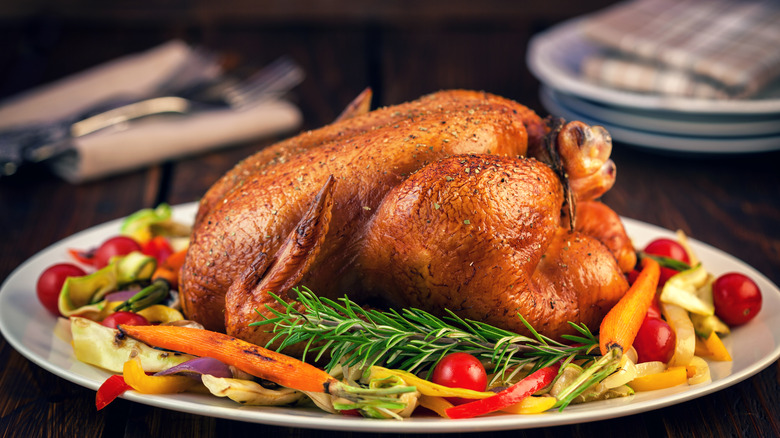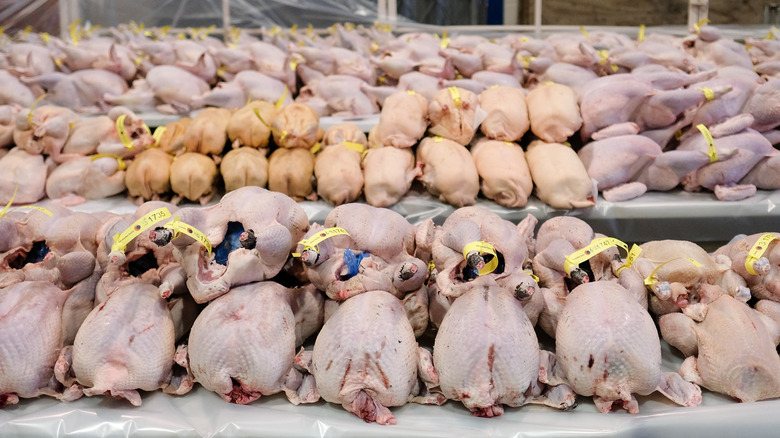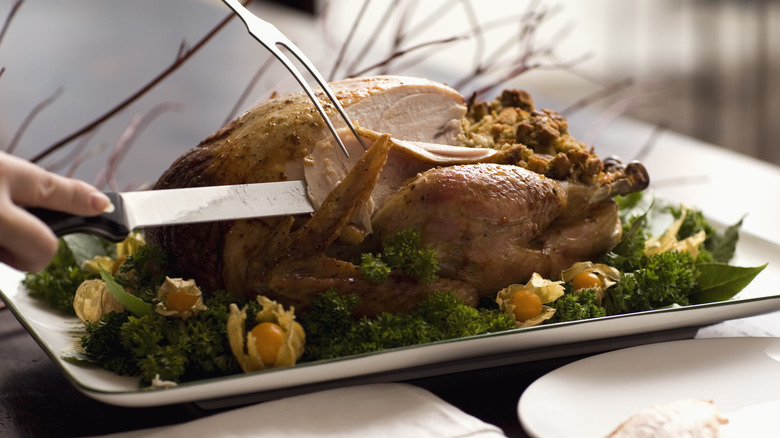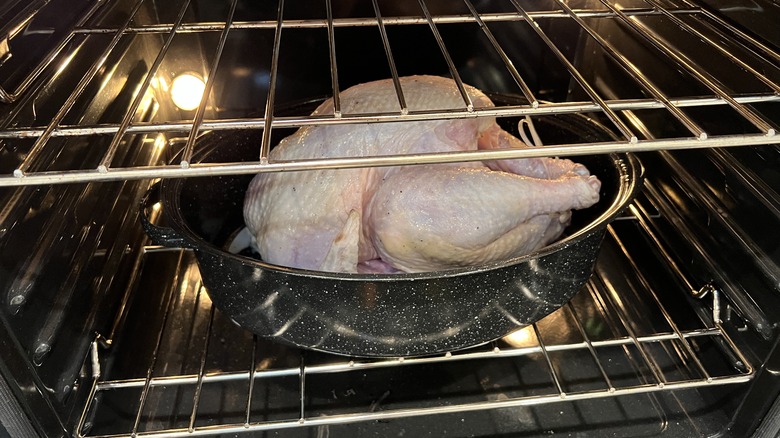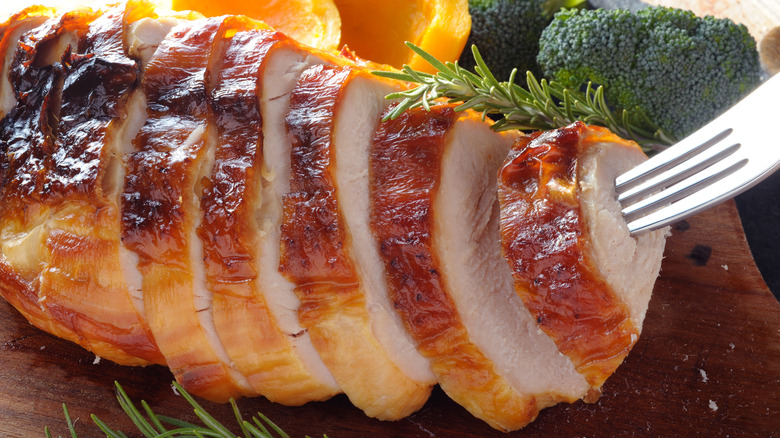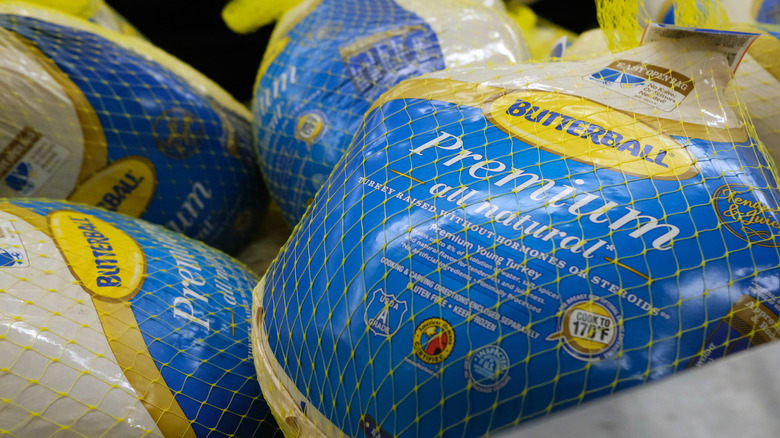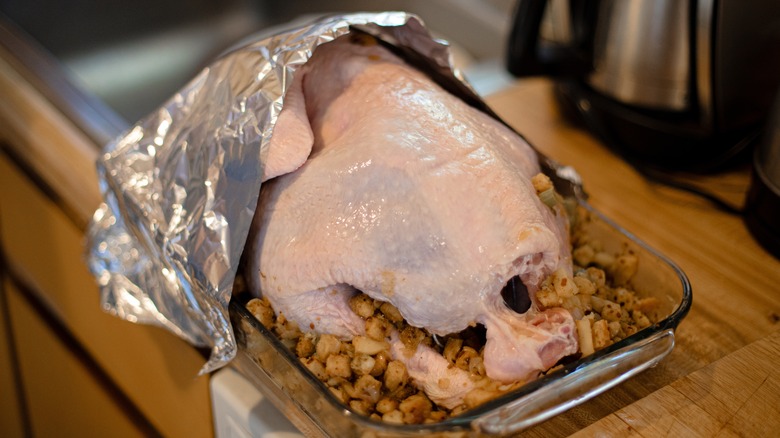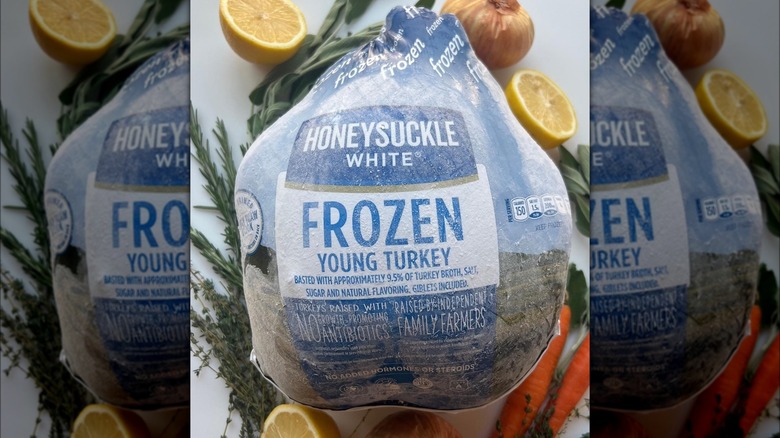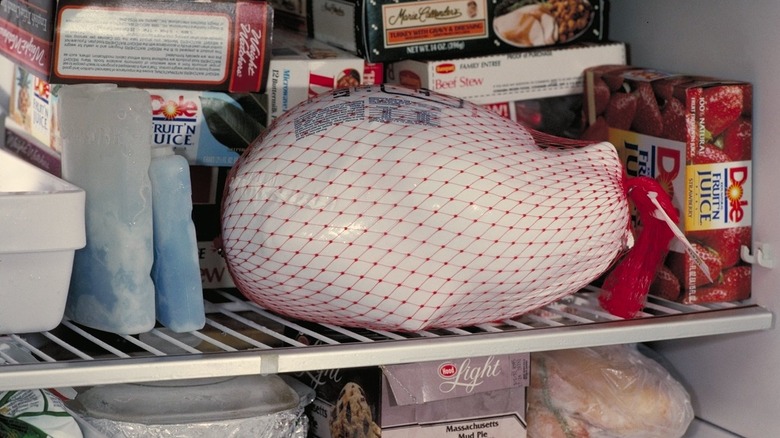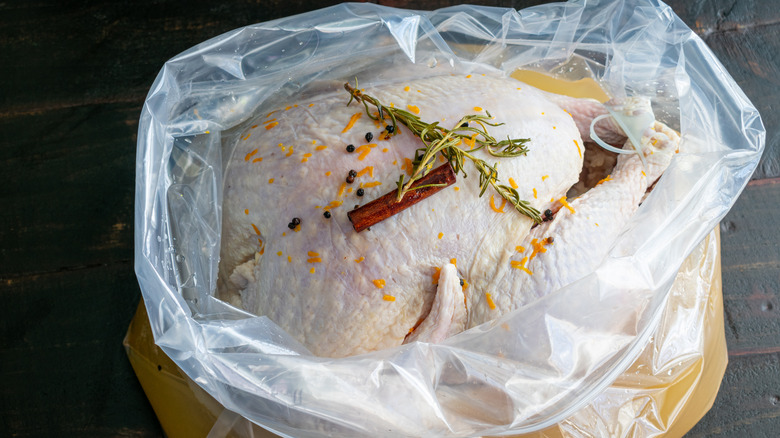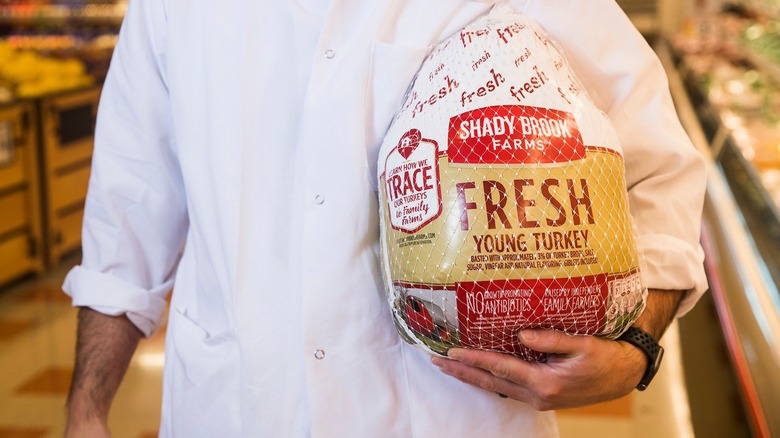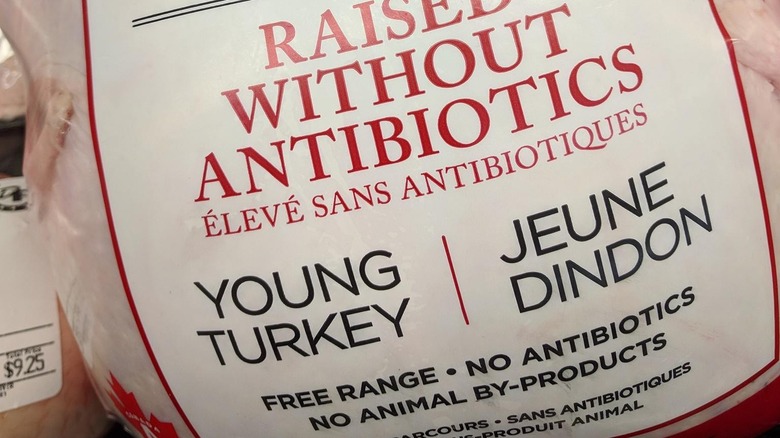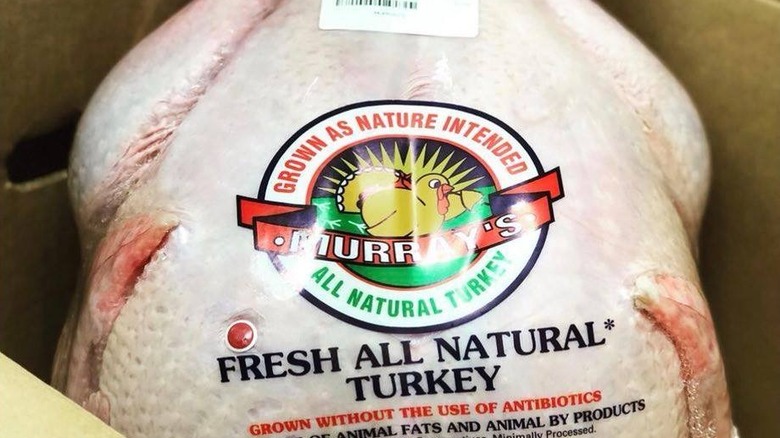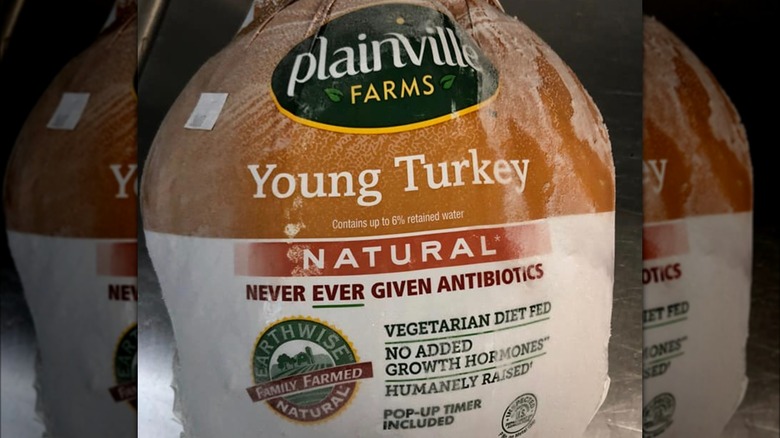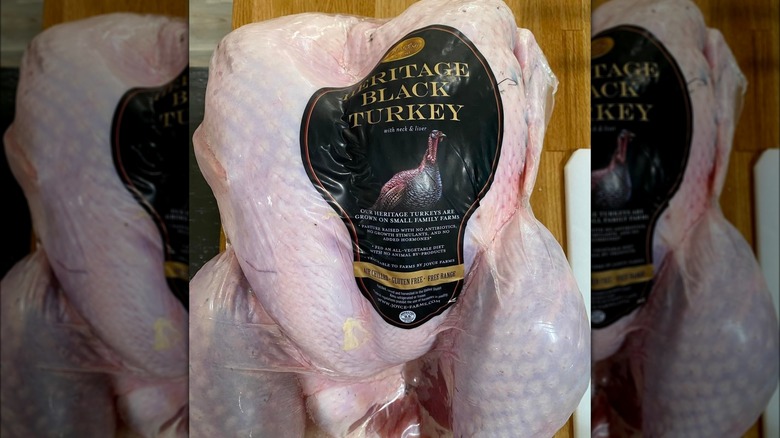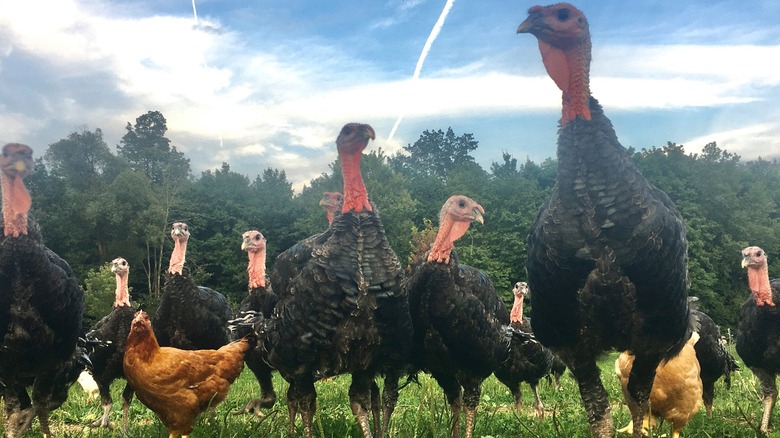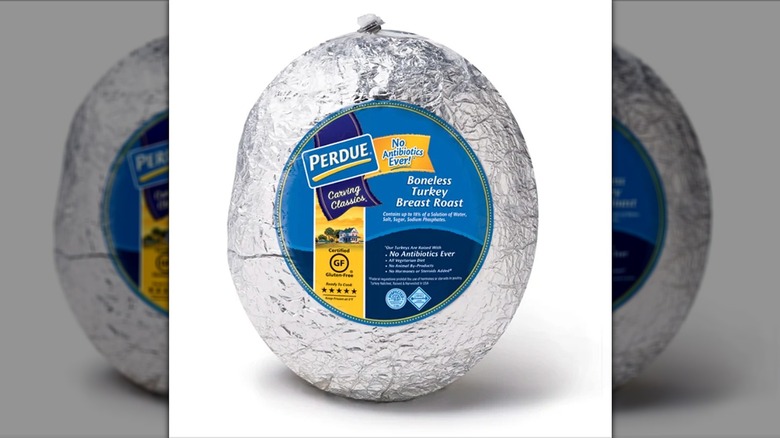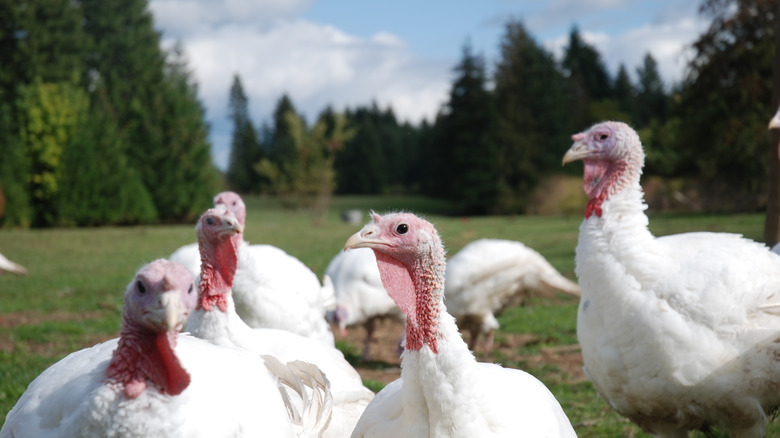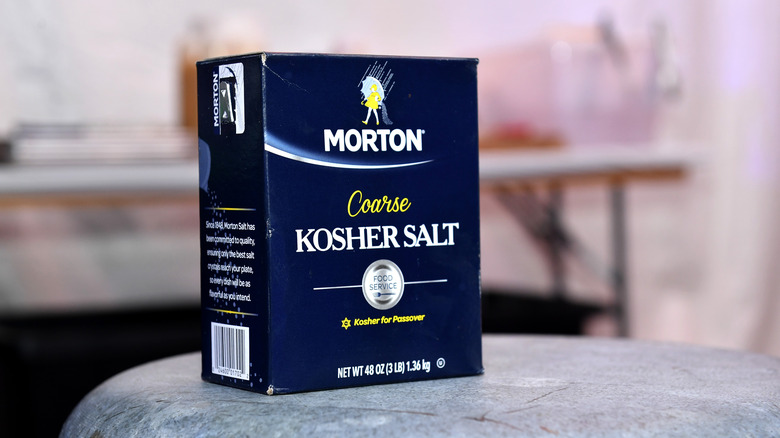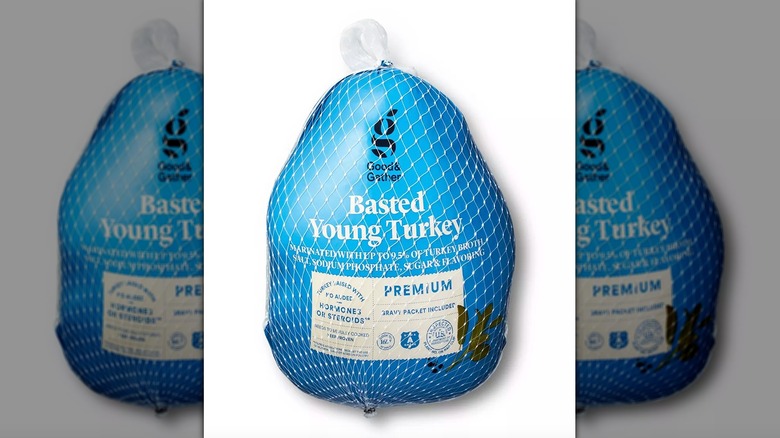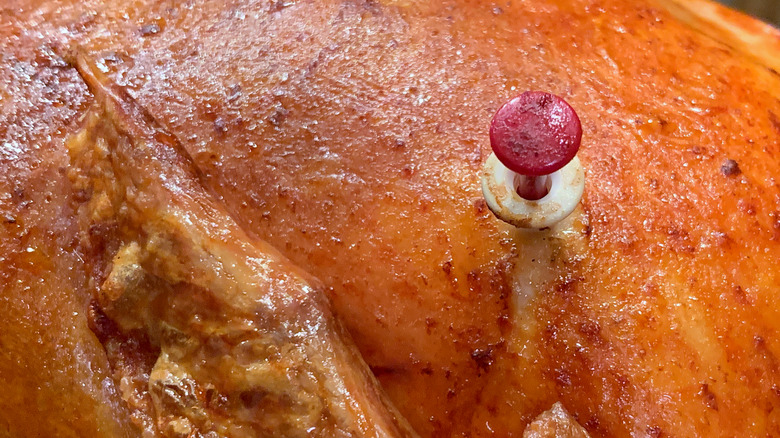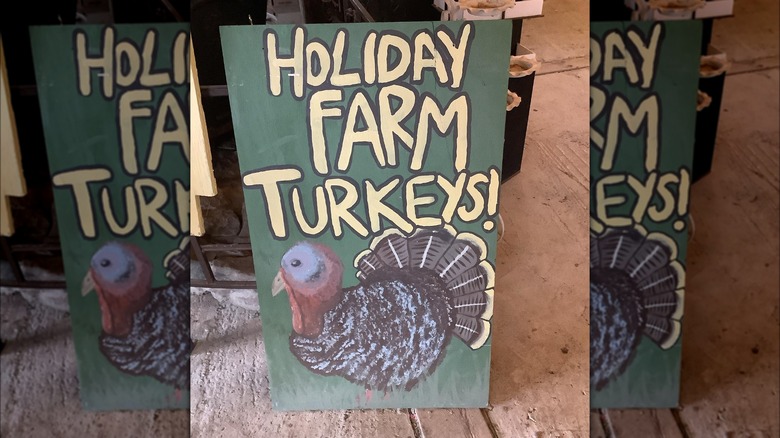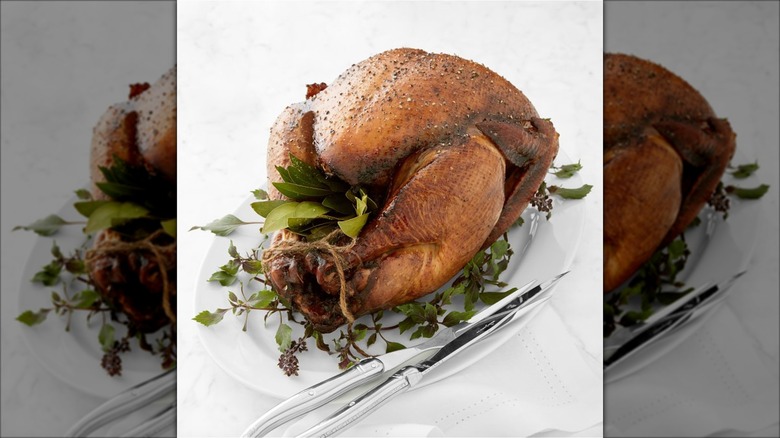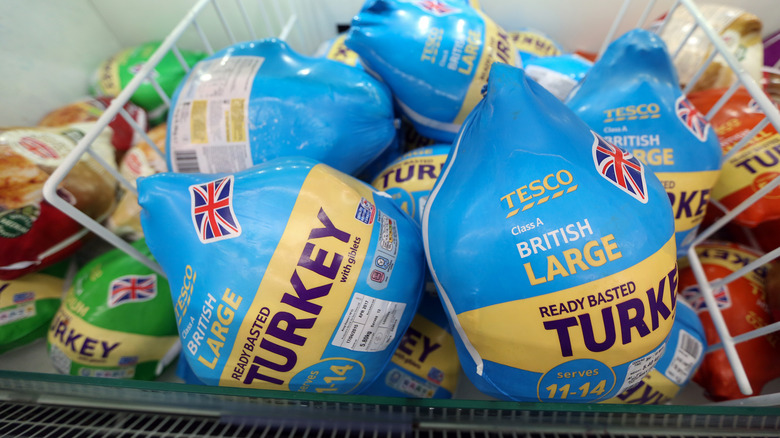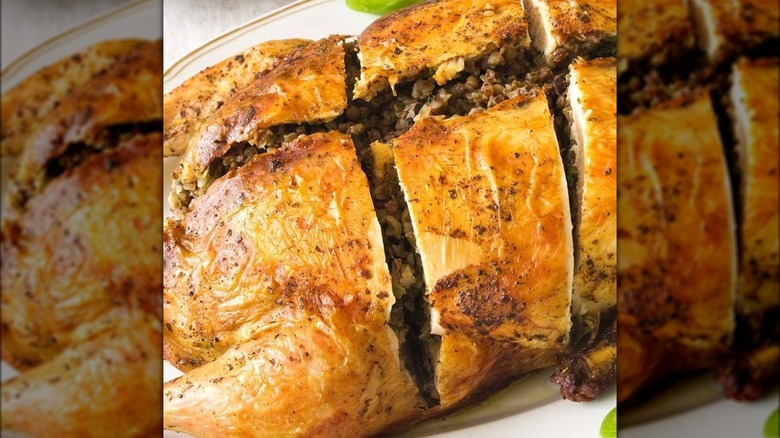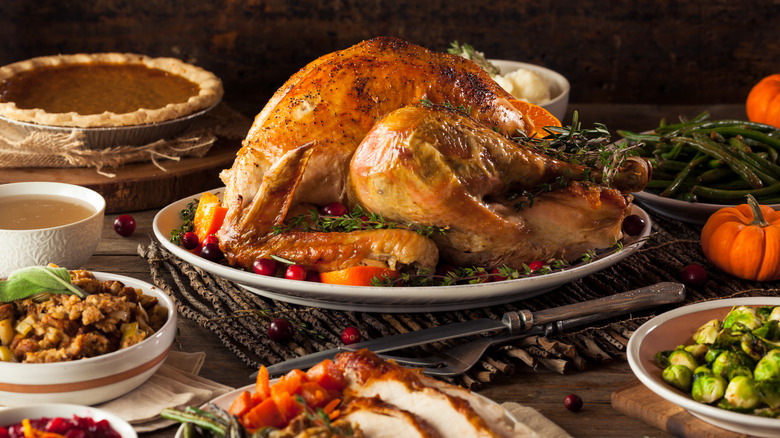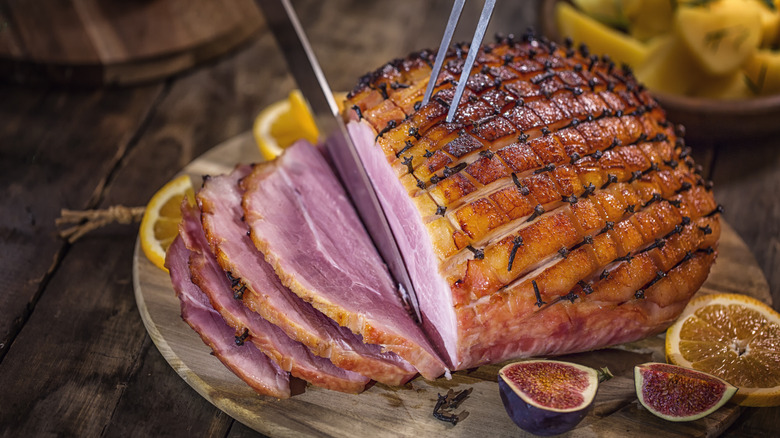28 Insider Tips For Picking The Perfect Thanksgiving Turkey
With Thanksgiving just around the corner, many of us are starting the planning process for the big day. While this can involve everything from assembling your guest list to decorating the house, it also means deciding on the bird to feature as the star of your Thanksgiving dinner.
Figuring out what kind of turkey to purchase for the big day is somewhat daunting, especially when so many options exist. There are several factors to consider when deciding upon the ideal bird. These can range from the individual palates of your guests to practical things, like how much space you have to store all of the groceries you will need. Throw in crazy labeling and health halo terminology, like "natural" and "farm fresh," and picking the perfect turkey becomes practically overwhelming.
That's where I come in. As a chef with many years of experience, I have hosted numerous Thanksgiving dinners. While others frantically run around the grocery store, I remain calm. I have the advantage of a few tips and tricks up my sleeve, which I will share with you. Hopefully, these will help take the guesswork and mystique out of what to look for to get the most succulent, delicious bird possible for your holiday needs.
1. Pick the right size
Perhaps the most critical factor in planning which turkey to buy is to decide on the size bird you will need. Most experts agree you should estimate 1 ½ pounds of meat per person. This means you will need about a 15-pound bird for a family of 10 people.
If this seems like a lot, keep in mind that a lot of the weight of a turkey comes from the carcass rather than from meat. It is also important to note that larger birds have a higher meat-to-bone ratio than smaller ones. This means a large turkey will yield more meat than a smaller one.
If you like leftovers, you should aim for a slightly larger turkey. I typically order about 2 to 3 pounds more than I need to accommodate my guests. This yields enough leftovers to both freeze and refrigerate.
2. Buy two smaller turkeys
Opt for two equal-sized smaller turkeys than one mutant herculean bird if you expect a large crowd. There are a few advantages to this. First, smaller birds are easier to handle than big ones. They also thaw much faster. And they take less time to roast, freeing your oven up for other dishes. Smaller turkeys are also easier to carve and tend to have more tender meat.
Just remember that smaller birds have a lower meat-to-bone ratio, so you will likely want to increase the amount of meat you need to two pounds per person to offset the difference. This would mean you would need two 10-pound turkeys for a family of ten rather than one 15-pound bird. You will also need to be more attentive to how you roast your turkeys to ensure each bird reaches the minimum safe temperature of 165 degrees Fahrenheit before removing it from the oven.
3. Get a bird that fits in your oven
Before you invest in a large turkey, you will want to ensure you have a roasting pan big enough to accommodate it and that you can fit both into your oven. For a turkey to roast evenly, you should allow plenty of space surrounding the bird for proper airflow. This means you must have at least 1 inch of space around all sides of the bird, including the back of the oven wall.
No standard size weight-to-oven ratio exists to guarantee a turkey will fit. Every bird has a distinct shape and proportions. This has to be factored into your purchasing decisions. It is best to know the exact dimensions of your oven before buying a turkey and using those measurements to assess if a bird will fit. Instead of trying to eyeball it, use a measuring tape.
4. Opt for turkey breast
There are several reasons why opting for a turkey breast rather than a whole turkey makes sense. First, if you have a family that does not care for dark meat, the breast yields all white meat, which they will love.
It is also less expensive if you factor in the weight-to-meat ratio, which will vary depending upon whether you purchase a bone-in or boneless turkey breast, but is still higher than a whole bird. Turkey breast is also far quicker and easier to thaw, cook, and carve. Finally, a turkey breast can be preferable if you are short on oven space.
When estimating how much to purchase, you will want to aim for roughly a pound per person or slightly less if you opt for a boneless turkey breast. If you can find one, purchase a turkey breast with its skin intact. It will yield a more moist result than a skinless breast.
5. Look at the age and sex of the turkey
According to the USDA, a turkey that is labeled "young" must be under 8 months old and can be either male or female. While doing so is optional, some turkeys will be marked as either a "hen," which is female, or a "tom," which is male. These designations have less to do with potential quality or tenderness than size. Large turkeys tend to be male, while smaller ones are generally female.
While the Old Farmer's Almanac suggests that toms are fibrous when young and get more tender as they age, as a general rule, smaller, younger turkeys are more supple than older, larger ones. This may be another reason to purchase two smaller turkeys rather than one large one. That said, there are plenty of ways to tenderize even a large turkey, including using a brine and coating the bird with a compound butter.
6. Check for damage to the packaging
Turkey can and should be stored in its original packaging. This includes fresh and frozen turkey in the freezer and the refrigerator. A turkey should also always be thawed in its original packaging intact. Never remove a bird from its packaging before thawing it, and don't wash your turkey, as this can increase the risk of cross-contamination.
You should overwrap turkey in another layer to prevent freezer burn and cross-contamination if the packaging accidentally gets nicked. If you notice the packaging of a turkey has been damaged at the store, buy another one. This can indicate the bird may have been exposed to contaminants and has experienced freezer burn. The best practice is to always inspect the packaging of your bird before purchasing to ensure it is safe to eat.
7. Why buy a fresh turkey
While fresh birds are often touted as superior to frozen, there may be less of an appreciable difference between them than you might think. As per the USDA, a turkey labeled as "fresh" cannot be chilled below 26 degrees Fahrenheit after processing. Fresh birds may retain more moisture because they are never frozen, which can yield a juicier, more flavorful result, but this is easily remedied with a frozen bird.
While fresh birds can frequently be organic and pastured, this is not always the case. They also generally cost more and are difficult to obtain at the last minute. Finally, fresh turkey should never be stored in the refrigerator for longer than two days before cooking. If you have the refrigerator space and can guarantee a turkey has been raised organically and pastured, you may consider buying one. If not, there is no reason to splurge on a fresh bird.
8. Why buy a frozen turkey
In contrast to a fresh turkey, the USDA requires a frozen turkey to be chilled to 0 degrees Fahrenheit or below immediately after processing and kept there. Because they are frozen at the height of freshness, there is no opportunity for the turkey to deteriorate, making it a safer option as long as the bird is correctly thawed.
Frozen birds can be conventionally farmed or certified organic. They can be purchased from the supermarket, straight from a local farm or butcher. The key to buying a quality frozen bird is to check for any indication that the bird has been thawed and refrozen. If there is damage to the packaging, you notice indentations in the breast of the turkey or see visible freezer burn, the turkey may not have been kept at 0 degrees Fahrenheit and may be unsafe to consume.
9. Know your freezer limitations
When deciding on the weight and type of turkey you purchase, fresh versus frozen, you will want to consider your freezer size and how full it is. Not everyone has a backup freezer or a walk-in like a restaurant does.
If you do not have adequate freezer space to store a 15-pound turkey, it may make sense to get a fresh turkey. Alternatively, you might plan to purchase your turkey just far enough in advance of Thanksgiving day to put it directly into your refrigerator to begin the thawing process.
It is also worth noting that you can purchase a turkey well in advance if you find a deal or want to stock up. Turkeys will last in the freezer forever if they don't sustain any freezer burn or are not otherwise compromised. Consume your turkey within one year of purchase for the best flavor and texture.
10. Make sure you have enough refrigerator space
It is equally important to factor in refrigeration space when considering the weight and type of turkey to purchase. Again, not everyone has the luxury of having a backup refrigerator to store or safely thaw a 15-pound fresh turkey for four days.
Additionally, remember that you will need space to store any other perishables you purchase for your Thanksgiving meal, which can impact your ability to refrigerate a large turkey. If you do not have enough refrigeration space to thaw a turkey safely, wait to purchase it the evening before Thanksgiving and use the cold water thawing method.
This should take about 30 minutes per pound of meat. A 15-pound turkey will take roughly seven and a half hours to thaw. Keep in mind that this is an active thawing method, which means you will not get much sleep that way, but your turkey will stay safe to consume.
11. Considerations for brining a bird
Brining can help to season and tenderize a turkey, but it isn't always recommended. You should always check a frozen bird to ensure it has not been injected with a salt-based solution, is enhanced, or is pre-basted. This will result in an inedible turkey.
You also want to avoid brining a kosher turkey. These, too, have been pre-seasoned, which can result in an overly saline bird. Other considerations include factoring in extra time for brining, which can take up to two days for a heavier bird.
Make sure you purchase a frozen bird well enough in advance to thaw and brine your turkey. Finally, the ideal bird for brining is a fresh, local, heritage breed of turkey with less white meat that tends to be more fibrous. This bird benefits most from this process, helping accentuate its flavor while improving its texture.
12. Know what the dates on the label mean
When purchasing a fresh turkey, it is recommended to buy it no sooner than two days before you cook it unless there is a label on the packaging indicating otherwise. The USDA suggests you will be looking for words like "Best by" or "Use by." These labels will ensure the bird is okay to consume until the date indicated.
For all other perishables, similar labels such as "Best if Used By/Before," "Freeze-By," and "Sell-By" are not safety labels. They are intended to indicate when to consume or cook a product for optimum quality and flavor or an indication for the retailer of how long a product can be on display. Regardless of the date indicated, always store your fresh turkey at a safe temperature below 40 degrees Fahrenheit and cook it to 165 degrees Fahrenheit.
13. Hormone-free is meaningless
According to the USDA, the use of hormones is prohibited in poultry rearing. Labeling a turkey with words like "hormone-free" or "no hormones added" is forbidden without the inclusion of the phrase "Federal regulations prohibit the use of hormones" on the packaging.
This is an example of what is known as health halo labeling. It is a term used to mislead consumers into believing they are somehow purchasing a superior, healthier product because it is included. It is crucial as an informed consumer to understand that in terms of added hormones, all turkeys are the same, regardless of whether they are fresh, frozen, organic, or conventionally grown.
14. Know what all natural means
All-natural is a term slapped onto products of all kinds, including meat and poultry. According to the USDA, its legal definition of poultry is that the meat was minimally processed without any added colors or artificial ingredients. The definition expands on the terminology minimally processed to mean that the product was not fundamentally altered during processing.
From a practical perspective, there are no third-party regulatory bodies to verify these claims. It can apply to any meat, whether it was raised organically or conventionally. It does not indicate quality, better animal welfare, or increased nutritional value. In other words, it is useless. All it ensures is that its product is safe to consume. While it isn't a health halo term per se, it also has little to no value to you as a consumer.
15. Avoid vegetarian-fed
When purchasing a turkey, vegetarian-fed may not be the best option. While there are legitimate concerns regarding what animal by-products are being fed to your Thanksgiving bird, turkeys are not vegetarians. They are omnivores that thrive off a diverse diet to meet their nutritional needs without supplementation.
Vegetarian-fed poultry is considered by many to be yet another health halo term that does have a legitimate meaning. Animal by-products can be a potential source of cross-contamination for various diseases, like salmonella.
These are eliminated when a turkey is properly cooked to a minimum internal temperature of 165 degrees Fahrenheit. It does not indicate the turkey is healthier for you or enjoys a better quality of life on the farm. Factors like organic certification are far more reliable if you are concerned with animal welfare and meat quality.
16. Get a heritage turkey
If nostalgia, sustainability, and flavor are your jam, consider investing in a heritage-breed turkey this Thanksgiving. Though they are more expensive, there are many reasons to love them. Heritage breed turkeys hearken back to a period before factory farming. These naturally mating birds are often smaller, have a more balanced white-to-dark meat ratio, and tend to have a gamier flavor.
Though heritage turkeys are often organic and pastured, that is not always a guarantee. These birds are slaughtered on average far later than commercially grown birds, giving the meat a denser, more fibrous texture that can benefit from some brining and requires a shorter cooking time.
When prepared with finesse, a heritage turkey can be a delicious option that perpetuates rare breeds and a throwback to simpler times. You can obtain a heritage breed online or from a local farm. They are available both fresh and frozen.
17. What pastured, free-range, or cage-free means
As per USDA regulations, free-range or free-roaming turkeys, sometimes called pastured or cage-free, are raised with availability to access the outdoors. While this has some appeal to consumers envisioning turkeys roaming on grassy fields eating bugs to their heart's content, this is not always the case.
In actuality, many commercially produced turkeys qualify for this labeling if there is a space available to go outside, even if they never do so. Again, this is not a health halo label per se, but it is a cautionary tale for consumers.
To ensure that your turkey lives its best life, eating nutritious food, you should obtain a turkey directly from the farm or with inside information on the farm where it was raised. First-hand knowledge of the animal husbandry practices of a farm will make the hefty price tag for a free-range bird less of a crap shoot and more of a guarantee of quality.
18. What about antibiotics?
Many consumers are purchasing a turkey labeled "no antibiotics added" out of concern regarding the proliferation of antibiotic-resistant bacteria. That said, this term may be somewhat misleading.
The USDA does require that manufacturers using this term on a label present documentation verifying these claims. To ensure a turkey producer did not use antibiotics at any stage, you will want to look for a USDA Process Verified seal, which indicates that USDA inspectors visited the farm directly to guarantee its claims.
According to the Iowa Farm Bureau, turkeys are restricted from being administered antibiotics before slaughter and tested to confirm no residual antibiotics are found in their bloodstream before being placed on the market. In this case, the likelihood of having antibiotics in your turkey is slim. However, if you are still concerned, search for a certified organic bird instead of one labeled "no antibiotics added."
19. Benefits of organic
Purchasing an organic turkey may be the best way to ensure you obtain a bird free of antibiotics or antifungals. Any bird sold with the "organic" label must adhere to USDA guidelines.
These include raising the animals in as natural an environment as possible, which is code for having access to the outdoors. It also requires restricting the use of antibiotics and hormones. Finally, these birds must be fed a 100% organic diet.
Furthermore, USDA organic standards prohibit using artificial flavors, colors, or preservatives in the processing and packaging of meat. It also strictly prohibits the use of GMOs and bioengineering. While the jury is out regarding the relative safety or potential hazards of consuming GMOs, opting for an organic turkey may make sense for those with concerns.
20. Why buy Kosher?
A turkey labeled as Kosher must be processed under rabbinical supervision. This is frequently overseen by a third-party organization, like OU Kosher, to guarantee that the meat has been reared and processed by strict guidelines outlined in the Torah.
Careful slaughtering practices using a very sharp blade administered to the trachea and esophagus of the bird, known as shechita, are intended to minimize the amount of pain the animal experiences in slaughter. Proponents insist that this produces more flavorful meat.
Once the turkey is slaughtered, it is inspected for quality and salted to help remove additional blood from the animal. This acts as a pre-brining process, which can have the same effect as tenderizing the meat. For this reason, kosher birds are unsuitable for brining and should never be over-seasoned.
21. Avoid a self basting turkey
According to the USDA, turkeys that are labeled as "basted" or "self-basted" are injected with a marinade including fat, liquid, seasonings, and flavorings that have been pre-approved for use to assist with adding moisture and taste to the bird as well as enhance the ability of its skin to brown. The solution cannot legally exceed 3% of the net weight of the bird and must be precisely listed on the packaging.
While convenient, pre-brined or enhanced turkeys can often turn out overly salty and somewhat mushy in texture. You are also paying for excess water weight rather than for actual meat. Lastly, you may need to pay particular attention to the ingredients in these solutions, as some may be problematic for those with various allergies. For more precise control over flavor, texture, and ingredients, wet or dry-brine the bird yourself.
22. Skip the pop up timer
You probably cannot avoid purchasing a turkey with a built-in pop-up timer, as many automatically come with them. These devices include a temperature-sensitive metal gauge designed to melt when it reaches 165 degrees Fahrenheit. Once this occurs, a spring activates a red stick to pop up.
In theory, this is a convenient, easy, and foolproof way to ensure you have a perfectly cooked turkey every time. Unfortunately, they are notoriously unreliable. They often fail to deploy and may not register at the correct temperature, yielding an over or under-done bird.
It is best to use an oven-safe or digital meat thermometer as a backup to confirm the doneness of your turkey. Fun fact: The pop-up timer in your turkey can be reused. Rinse the device in hot water, allow it to cool completely, and pop the red stick back into its base.
23. Buy local
As you may have assessed, labeling on turkeys can be challenging to decipher, and many are wildly unreliable, if not downright misleading. What should you do to ensure you purchase an organic bird that has had the chance to roam on a pasture and has lived its best quality life while reducing its carbon footprint? Buy local.
Doing so can deliver a delicious Thanksgiving bird you can feel somewhat better about eating. You can ask the farmer exactly what the bird was fed, how it was housed, and where it was processed. Moreover, purchasing from a local farm supports the local economy, ensuring those dollars circulate within your community. That is a win-win. Lastly, it enables you to build a personal relationship with your farmer, which is rewarding and creates a sense of reciprocity that benefits both parties.
24. Buy online
Purchasing a turkey online has numerous advantages, the main one being avoiding the crowd at the grocery store. You can easily search for a bird based on the criteria that are most important to you. Finding a heritage, organic, pastured, or pre-seasoned turkey in the precise size you need is as simple as a Google query. And many companies offer free shipping. Additionally, some birds might be more affordable than at the grocery store.
The two chief complaints when ordering online are restrictions on size, particularly for large birds, and shipping issues. While companies have gotten efficient and clever at developing shipment methods for delivering perishables, they are not always foolproof. There are often issues with damaged boxes or birds that have been thawed or compromised. And shipping can be expensive when not included in the price.
25. Buy from the supermarket
If cost and convenience are chief criteria in selecting your Thanksgiving turkey, purchasing your bird from the supermarket is the best option. Not only is it one-stop shopping, you can find myriad varieties of birds, from conventionally raised to organic.
You can also find store-brand birds, which will involve considerable savings. Many of these brands are produced by the same manufacturers but purchased in bulk by the retailer, which means you get the same quality for a far lower price.
Big box stores can offer even deeper discounts, saving you even more. Just remember to look for birds that are well sealed with no damage to the packaging or signs of blemishes to the meat.
26. Skip the stuffing
Plenty has been written about the dangers of stuffing your Thanksgiving turkey. The USDA also recommends against purchasing a pre-stuffed bird. As is noted, the interior of a turkey is a fertile environment for the proliferation of bacteria. Ensuring the stuffing can reach a safe internal temperature of 165 degrees Fahrenheit without overcooking your turkey is quite challenging.
If you insist on purchasing a pre-stuffed bird, there is only one safe way to do this. Opt for a pre-stuffed frozen turkey processed and packaged in a USDA-certified facility. These should be marked with a USDA or state certification seal of approval. All pre-stuffed frozen turkeys should be prepared according to packaging directions to ensure safety.
27. Buy pre-cooked
There is much to love about purchasing a pre-cooked turkey versus roasting one yourself. It saves you time thawing and cooking and frees up valuable oven real estate for creating side dishes. Additionally, the potential options are vast in types of pre-cooked turkey you can try. Not only are there unique seasonings, but you can mix things up by purchasing a smoked turkey with a distinct texture and flavor.
The only potential downside is the price tag. Pre-cooked turkey can be obtained online or via various grocery stores. Those purchased online may cost a pretty penny for shipping. The benefits will likely outweigh the costs when you factor in the extra time you spend with family and friends.
28. Consider an alternative
While turkey is no longer in limited supply, bringing the per pound cost down on average from last year, there are still many reasons to consider an alternative to a turkey this Thanksgiving. First and foremost, as hard as it might be to believe, some people just don't turkey. You also may not want to deal with the hassle of thawing and roasting a turkey. Finally, you may not have adequate freezer, refrigerator, and oven space to store and cook a turkey.
Ham is a common alternative to turkey, as is a beef tenderloin or rib roast. You may also consider something more out-of-the-box, like a leg of lamb or even a whole roasted fish. And if you want to simplify things, consider creating a vegetarian or chicken casserole with umami-rich mushrooms to satiate your crowd. Whatever you decide, the main thing is to enjoy the time with family communing over a homemade meal.
